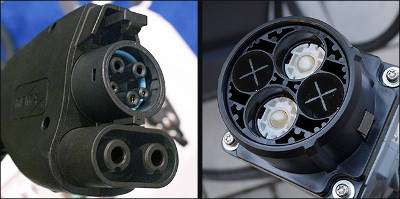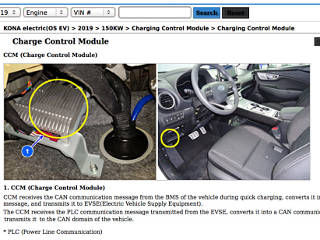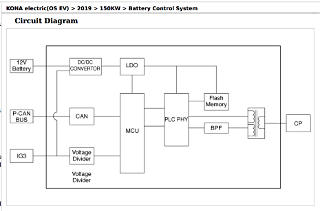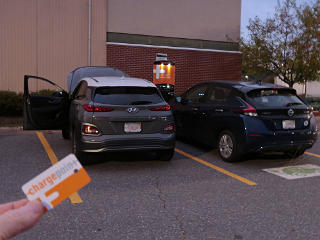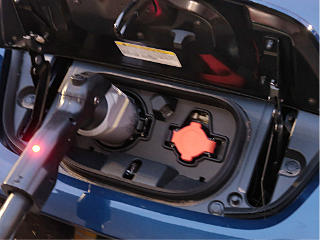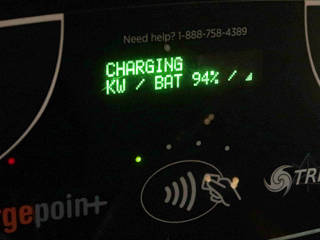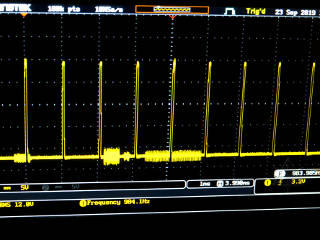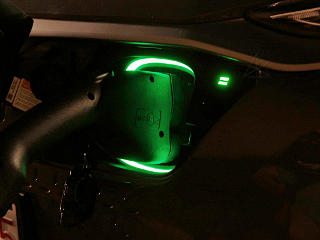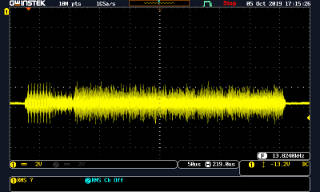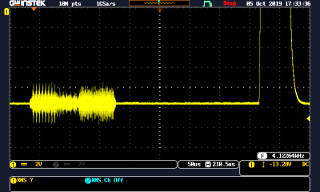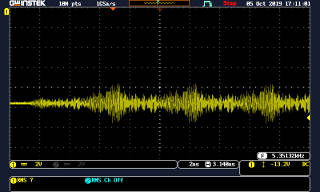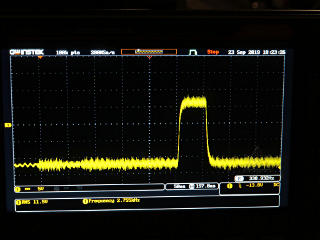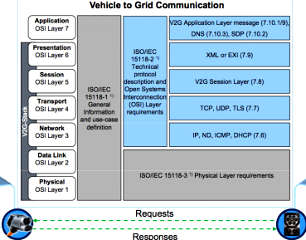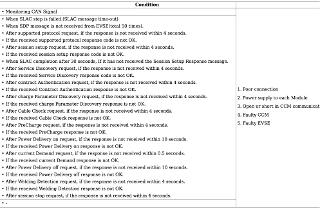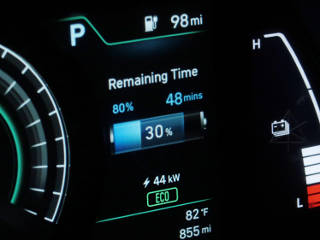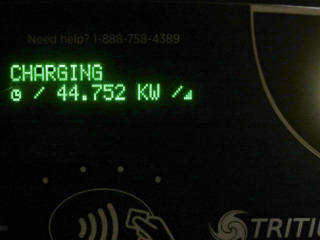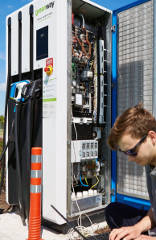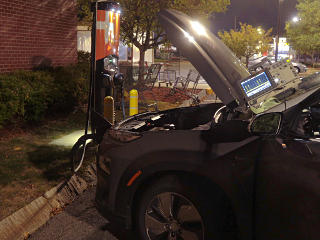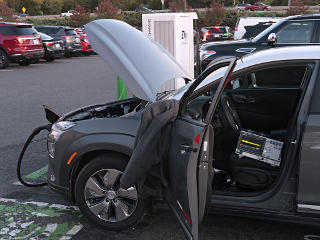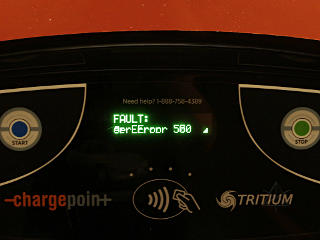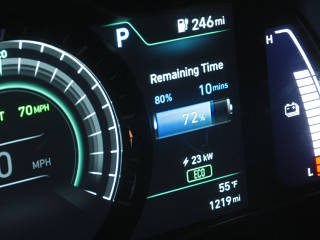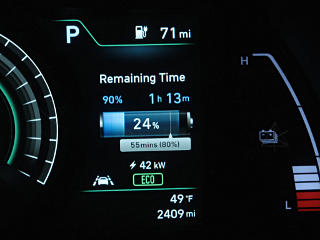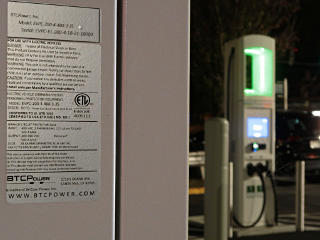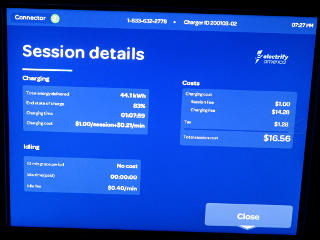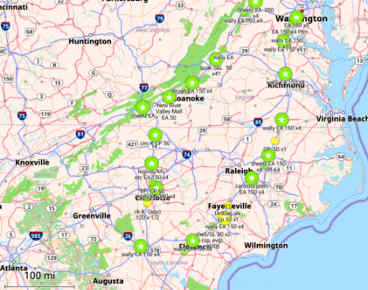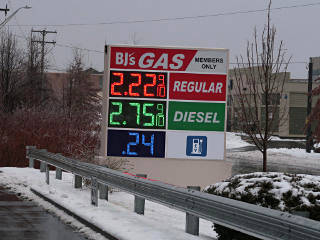Long roadtrips done electrically are a different story, and that's the most common situation where DC fast-charging is needed. This brings up the headache of finding out where rapid-chargers are, which billing network they're on and *how* they bill, as well as which charging protocols they support. I described the present state, as of late 2019, to colleagues thusly: take a fairly efficient 50-ish MPG car like a Prius, and outfit it with a 5-gallon gas tank instead of the stock 11 or 12. Now, take away 90% of the existing gas stations, and then try to plan your roadtrip. Fortunately, there are plenty of apps for that, but without the internet you're basically hosed. You can't just spot a charging place on the fly along a major highway and pull in. [It gets even more confusing during any conversation about this, where "charging" can interchangeably refer to 1> pushing energy into the car, or 2> pulling value out of your wallet.]
But the most confusion we encounter is about the electrical standards used for high-power vehicle juice-up. Put as simply as possible, we basically find three different connector types in the US at this time: CCS, CHAdeMO, and of course Tesla's own proprietary thing. And that's just the physical plug, where the only feature common to all of them is a pair of big honkin' pins to send current straight into a car's battery. The data interactions are the other layer of incompatibility, so there's no such thing as a simple passive connection adapter from plug A to car B.
Non-Tesla standards seem to be settling on CCS or the Combined Charging System, an extension of the J1772 connector that's been around for a while. It seems to be slowly gaining ground over CHAdeMO, but the process has not at all been a pain-free one. This is the result of a bitter battle back around 2010-2011, and it's still not clear how things will eventually settle out. As many other articles about this have mentioned, it's VHS vs. Beta all over again, and the standard that eventually prevails is likely to do so because of money far more than technical merit. Frankly, if everyone had adopted the European "type 2" variant of J1772 and its extension to CCS, then we could have traditional Level 2 home charging, faster three-phase AC charging such as in commercial fleet environments, and high-power DC charging all in a single connector. It is very telling that Tesla is moving toward type 2 CCS for superchargers across the pond, but are still hiding in their walled garden in the US. [Well, up until 2023, when Tesla started pushing very hard for their connector to become the "standard" instead, passing either Tesla-proprietary CAN protocol or CCS/ISO15118 via PLC over it. Developing story.]
In the meantime, US drivers still face an unholy mess. Charging networks are trying to build out regardless, by simply putting two or even three types of plugs and protocol support on their high-power deployments. They don't know what else to do, but the infrastructure needs to be installed. As stupid as it sounds, it's as though you pulled up to a gas pump in your ICE car and the pump had two or three different kinds of fuel nozzles hanging off it, and you had to pick the right one for your filler and hope it's not the one that got vandalized last night. High-speed EV charging is also far more complex than opening a valve and letting liquid fuel out.
Vice has a fairly poignant article about this clusterfuck which is worth reading.
Connectors have to be able to handle the high currents involved -- 200 or 300 or more amps for a sustained time, and the protocol for any system includes all kinds of lock-step safety and capacity checks. Cables for power levels at 100 kilowatts and beyond are starting to include liquid-cooling in their design, albeit with a few growing pains. That's an *assload* of power that we so casually talk about in this field, and it's kind of amazing that a vehicle can just quietly sit there and suck it all up. [To put that in perspective, pumping 10 gallons of gas into a car in two minutes is equivalent to over three *megawatts* of power, which would need about 10,000 amps into a typical EV battery, and that's only counting the *propulsive* energy stored. We are *SO* spoiled in terms of speed and perceived convenience.] Generally the car is entirely at the mercy of the rapid-charger's power supply, which could easily wreak major battery damage if not controlled carefully. There also has to be a lot of protection against disconnection under current load, to avoid destructive arc-faults in connectors and relays.
Tesla and CHAdeMO have adopted variants of CAN automotive networking for their car-to-charger control protocols, but the SAE and related consortia decided to extend the thinking for CCS to broadly cover the whole "vehicle-to-grid" concept. This made it inordinately complex [may redirect to "switch-ev.com"], which may be one reason it took so much longer to nail down a useful standard. It uses a type of data-over-power-line transport called "HomePlug Green PHY", except that in this usage the data doesn't actually travel over any power connections. The spec for the lowest-level protocol alone is *seven hundred pages*. I found a copy here, but it is a bit more manageable to dip into when rendered as a PDF [about 3 Mb]. The spec for "PEV - EVSE" interaction starts around page 671; have fun with that. The signaling is sent superimposed over the existing J1772 control-pilot line, so as implemented a vehicle supporting CCS wouldn't be able to participate directly in any V2G setups without the charging station doing some translation up to the larger conceptual "smart grid". Not to mention the need for either the vehicle or the charging station to have an inverter capable of supplying AC power back from the vehicle's battery in a grid-safe fashion! For all the blather about it through the 20-teens and into 2020 when we were all supposed to have our atomic-powered flying cars by now, we're still a long way from even basic V2G ever reaching reality.
It's all a work in progress, as gasoline fueling infrastructure doubtless was in its infancy.
